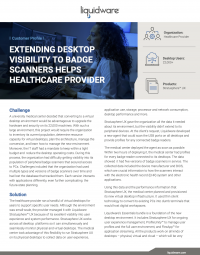University Medical Center Gets Comprehensive Visibility of Badge Scans
A university medical center decided that converting to a virtual desktop environment would be advantageous to upgrade the hardware and security on its 22,000 machines. With such a large environment, this project would require the organization to inventory its current population, determine resource capacity for virtual desktops, plan the architecture, manage the conversion, and learn how to manage the new environment. Moreover, the IT staff had a mandate to keep within a tight budget and reduce the desktop operating costs. During this process, the organization had difficulty getting visibility into its population of peripheral badge scanners that secured access to PCs. Challenges included that the organization had used multiple types and versions of badge scanners over time and had lost the database that tracked them. Each version interacts with applications differently, even further complicating the future-state planning.
The healthcare provider ran a handful of virtual desktops for years to support specific user needs. Although the environment was small-scale, the provider managed it with Liquidware Stratusphere UXTM because of its excellent visibility into user experience and system performance. Stratusphere UX works across all desktop platforms so it can simultaneously and seamlessly monitor physical and virtual desktops. The medical center took advantage of this flexibility to run Stratusphere UX on its physical desktops to collect data on user experience, application use, storage, processor and network consumption, desktop performance and more.
Stratusphere UX gave the organization all the data it needed about its environment, but the visibility didn’t extend to its peripheral devices. At the client’s request, Liquidware developed a new agent that could scan the USB ports on all desktops and provide profiles for any connected badge readers.
The medical center deployed the agent as soon as possible. Within two hours of deploying it, the medical center had profiles for every badge reader connected to its desktops. The data showed it had five versions of badge scanners in service. The collected data included the device manufacturer and BIOS, which are crucial information to how the scanners interact with the electronic health record (EHR) system and other applications.
Using this data and the performance information that Stratusphere UX, the medical center planned and provisioned its new virtual desktop infrastructure. It used thin client technology to convert its existing PCs into dumb terminals that would host digital workspaces.
Liquidware's solutions are a foundation of the new desktop environment. It includes Stratusphere UX for ongoing user experience management, ProfileUnityTM to manage user profiles and the full user environment, and FlexAppTM for application streaming. All the products work on all kinds of desktops – physical, virtual and cloud – which will be very valuable to the medical center as it transitions its 22,000 physical desktops to virtual ones during a three-year phased implementation.
The desktop migration is helping the medical center meet its urgent, immediate need to reduce operating expenses. The data Stratusphere UX provided enabled the organization to determine that it could operate its new virtual workspaces on its legacy PCs. That will extend the hardware life by four to five years, allowing the organization to defer a costly upgrade.
Because Liquidware solutions are cross-platform compatible, the organization doesn’t need to maintain separate tooling to manage its different desktop populations, which is another source of savings. Streaming applications to users instantly on-demand instead of building the apps into individual desktop images lets the organization support all its users with just a few base images, reducing the time and effort required for routine desktop maintenance.

